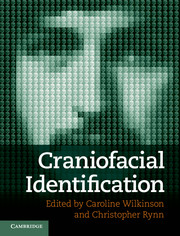Book contents
- Frontmatter
- Contents
- Contributors
- Part I Identification of the Living
- Part II Identification of the Dead
- Chapter 14 Post-mortem prediction of facial appearance
- Chapter 15 Manual forensic facial reconstruction
- Chapter 16 Relationships between the skull and face
- Chapter 17 Automated facial reconstruction
- Chapter 18 Computer-generated facial depiction
- Chapter 19 Craniofacial superimposition
- Chapter 20 Juvenile facial reconstruction
- Index
- Plate Section
- References
Chapter 17 - Automated facial reconstruction
Published online by Cambridge University Press: 05 May 2012
- Frontmatter
- Contents
- Contributors
- Part I Identification of the Living
- Part II Identification of the Dead
- Chapter 14 Post-mortem prediction of facial appearance
- Chapter 15 Manual forensic facial reconstruction
- Chapter 16 Relationships between the skull and face
- Chapter 17 Automated facial reconstruction
- Chapter 18 Computer-generated facial depiction
- Chapter 19 Craniofacial superimposition
- Chapter 20 Juvenile facial reconstruction
- Index
- Plate Section
- References
Summary
Introduction
Craniofacial reconstruction (CFR) can be a useful tool in the identification of a corpse that is unrecognisable due to its state of decomposition, soft-tissue mutilation or incineration, and if no other identification evidence is available. Traditional CFR methods are based on manual reconstruction by physically modelling a face on a skull replica with clay or plasticine. The progress in computer science and the improvement of medical imaging technologies during recent years have fostered the development of fast and flexible computer-based reconstruction programs. This chapter presents a comprehensive review of computerised three-dimensional (3D) CFR algorithms with particular emphasis on the more recent statistical based reconstruction methods, including a discussion of the various alternatives and problems that arise during the process of designing a CFR program.
Forensic identification of an unknown body is based on comparisons of ante- and post-mortem data, such as medical files, dental records, X-rays or DNA. Sometimes ante-mortem records are not available or incomplete; sometimes the preservation of DNA may be so poor as to make comparisons impossible. Similarly, when identifying features are completely missing or have decomposed beyond recognition but partial or complete skull fragments are available, CFR may assist the investigation. The goal of CFR is to recreate a likeness of the face of an individual immediately prior to their death. Different 2D and 3D manual or computer-aided CFR techniques have been developed for this purpose and all are based on the assumed relationship between the soft-tissue envelope and the underlying skull substrate.
- Type
- Chapter
- Information
- Craniofacial Identification , pp. 203 - 221Publisher: Cambridge University PressPrint publication year: 2012
References
- 5
- Cited by



